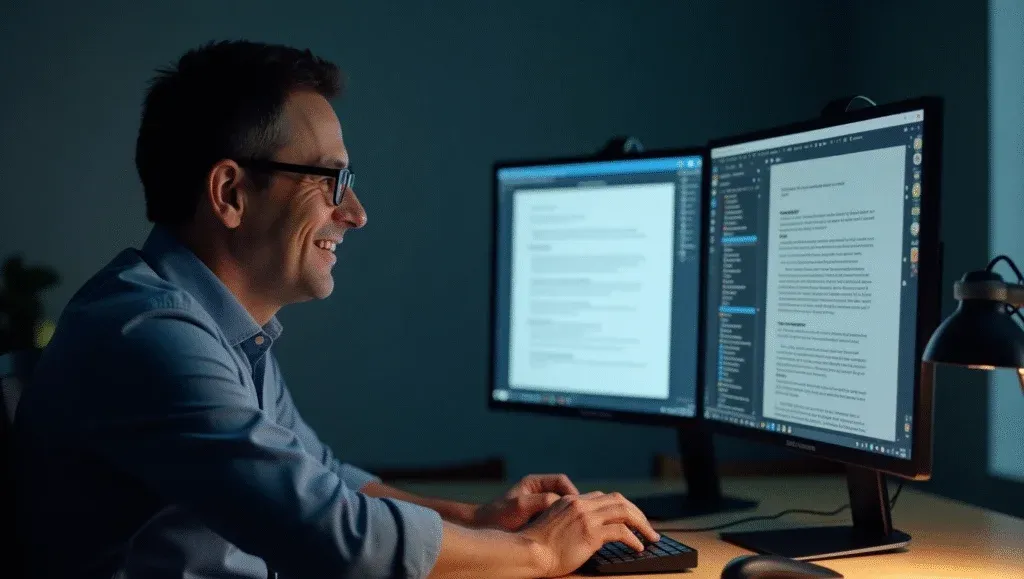When I first left full-time work due to my MS symptoms, I wasn’t thinking about career reinvention. I was thinking about survival — financial, emotional, and psychological. I needed to keep my mind active and my finances afloat, but traditional work hours were no longer realistic. That’s when the idea of a side hustle with MS started to take shape.
It didn’t happen overnight. There was no grand vision. Just the quiet frustration of being sidelined — and the growing realisation that I still had value to offer. I wanted to find a new way to contribute, learn, and earn — all while working around fatigue, brain fog, and the unpredictability of MS.
This is the story of how my side hustle with MS grew from a coping mechanism into a second act — a purpose-driven venture that now defines my career.
Why I Needed a Side Hustle with MS
Multiple sclerosis doesn’t just change your body — it alters your professional identity. Before my diagnosis, my career was rooted in engineering and on-site technical work. But increasing mobility issues and fatigue forced me to give up my driving licence, and with it, my ability to work as a field service engineer.
The transition was jarring. I went from solving technical challenges in the field to navigating a much more personal one: how to rebuild a life around work I could do from home. I needed a solution that offered flexibility, low stress, and a sense of achievement. What I found was a side hustle with MS that would eventually become so much more.
I needed a side hustle with MS to regain a sense of purpose, supplement my income, and prove to myself that a diagnosis didn’t mean the end of meaningful work.
My earliest ventures weren’t glamorous. I dabbled in blogging, explored earning extra income with MS through investing, and even took a serious look at affiliate marketing. Some attempts failed. Others showed promise. But all taught me something valuable: I wasn’t done yet.
The side hustle with MS gave me more than income. It gave me back a sense of agency. I could decide when and how to work. I could push through on a good day and scale back on a bad one. And I could build something meaningful — slowly, sustainably, and in my own way.
Today, I want to share what worked, what didn’t, and the surprising ways my MS-friendly side hustle reshaped my career and mindset.

Turning Point – When the Hustle Sparked
The moment that changed everything didn’t feel dramatic at the time. I was sitting at my desk, tinkering with a personal blog post — more as therapy than with any grand business ambition. But something clicked when a stranger left a comment thanking me for my honesty. That tiny ripple of connection made the whole thing feel worthwhile.
Around that time, I also began to take my school week side hustle more seriously. I called it that because I approached it like a five-day commitment — not quite a full-time job, but structured and regular enough to give my week shape. Monday to Friday, I dedicated short blocks of energy to writing, researching, and quietly building a digital footprint.
The turning point came when my side hustle with MS sparked more than just income—it reignited my confidence and reminded me I still had something valuable to offer.
It was never about chasing viral success. It was about pacing myself, learning something new, and proving to myself that I could still grow — even with a degenerative illness. Slowly, I began exploring part-time work ideas for MS patients that felt like a natural extension of what I was already doing: writing, helping others, and staying mentally sharp.

What Made It Work
Not all side hustles are created equal — and not all are suitable when you’re managing a fluctuating condition like MS. What made my approach sustainable was a combination of tech, timing, and temperament.
I used tools that made my workflow easier: a large-screen monitor to help with visual fatigue, dictation software for writing on bad typing days, and scheduling apps to help me plan around my energy dips. It wasn’t perfect, but it was mine.
The second key was flexibility. I learned early on that fatigue is sneaky — it can creep in like fog and flatten an entire afternoon. So I adopted time-blocking and focused on energy management. I worked in sprints, with rest breaks in between. I stopped aiming for 8-hour days and started aiming for productive hours — sometimes as few as two or three per day.
Above all, I reframed success. The goal wasn’t hustle culture glory. It was consistency. If I could keep showing up each day — even for a short time — I could build something that outlasted the hard days. That’s what an MS-friendly side hustle is really about: adapting the hustle to the body you live in now, not the one you used to have.
For a while, I even referred to my little setup as my week side hustle school — a private classroom where I re-educated myself about online publishing, affiliate programs, and personal branding. I wasn’t just trying to make money. I was trying to find relevance and purpose again.
What made my side hustle with MS work was a blend of flexible hours, genuine passion, and choosing tasks that aligned with my strengths and energy levels.
The Role of Curiosity and Learning
I’ve always been driven by curiosity — an engineer’s itch to understand how things work and why they fail. That drive never left me, even when MS made thinking harder than it used to be. In fact, finding ways to continue learning became part of my healing process.
I read books on blogging, watched videos about passive income, and experimented with design tools and keyword research. On days when my brain fog hit hard, I gave myself permission to learn in small sips — just one new thing, one new insight, one aha moment at a time.
Over time, this ongoing process of discovery became my own hustle school week side project — a humorous but oddly fitting phrase that captured the spirit of what I was doing. I wasn’t just building a side hustle. I was building myself back up, one lesson at a time.
My side hustle with MS was fuelled by curiosity and a constant desire to learn, turning limitations into opportunities for growth.

From Side Hustle to Career Pivot
Eventually, the tipping point came: the moment when my side hustle wasn’t just a backup — it was the career.
The blog started generating real traffic. I found a rhythm with my investing, and my skills sharpened. Then came the questions from others: How do you do this? Can you help me set this up too? That’s when I realised I wasn’t just working around my condition — I was building through it.
What began as a way to stay busy turned into a platform, a purpose, and yes — a profession. I was writing, teaching, building relationships, and even mentoring others who were curious about earning extra income with MS. The freedom, the flexibility, the fact that I no longer had to commute or apologise for needing rest — all of it added up to something far greater than a paycheck.
What began as a simple side hustle with MS soon revealed a sustainable path forward, ultimately guiding me toward a fulfilling career pivot.
The transition was subtle but profound. I stopped thinking of myself as someone who used to work and started thinking of myself as someone who still does — just differently now.
Small Business Ideas for People with MS
For others on the same path, I often recommend exploring small business ideas for people with MS that align with your unique pace and passions. Here are a few that are especially MS-friendly:
- Print-on-demand or Etsy storefronts – Great for those with a creative flair and patience for setup. Low overhead and runs on your schedule.
- Digital content services – Blogging, copywriting, and SEO consulting are flexible and scalable, especially if you enjoy research and storytelling.
- Remote tutoring or mentoring – If you have teaching experience or a specialism, this allows you to work part-time and build meaningful relationships.
And don’t underestimate the power of app-driven models. For instance, app development and data analysis platforms now offer low-code entry points, opening the door to even more accessible, automated income streams.

Lessons I Learned Along the Way
Building a side hustle with MS wasn’t just about work — it was about redefining what work meant to me. I learned that progress can be quiet and powerful. It can come in the form of showing up, not giving up.
Here are a few takeaways I’d offer to anyone starting out:
- Start small — You don’t need a business plan or branding guide to begin. You need curiosity, patience, and one clear next step.
- Be honest about your limits — MS will ask you to slow down. That doesn’t mean you’re weak. It means you’re adapting.
- Forget perfection — Some days will be bad. Others will surprise you. Build your routine with enough flexibility to honour both.
- Measure meaning, not metrics — Success isn’t always visible. If your work makes you feel more alive or more useful, it’s working.
Whether your hustle becomes your next career or simply a source of pride and pocket money, you’ll have built something powerful — a life that flexes with MS instead of collapsing under it.
Frequently Asked Questions
How to make money when you have MS?
Making money with MS is absolutely possible — it just requires a tailored approach. Many people explore MS-friendly side hustles such as blogging, freelance writing, tutoring, or remote consulting. Digital product creation, affiliate marketing, and even stock photography can also generate income with minimal physical strain. The key is choosing something flexible that matches your energy patterns. Start small, build slowly, and prioritise sustainability over speed.
How to make $2000 a month as a side hustle?
To make $2,000 a month consistently, you’ll likely need to combine multiple income streams. For example, you might earn from blog monetisation (ads or affiliate links), stock investments, and freelance work. Some people scale a school week side hustle — working focused hours Monday to Friday — into a predictable, reliable income source. The magic lies in repetition and refinement: do one thing well, then expand. And don’t overlook automated models like app development and data analysis platforms, which can scale more passively.
How to work with multiple sclerosis?
Working with MS requires a mindset shift: it’s not about keeping up, it’s about adapting well. Whether you’re in traditional employment or building a side hustle with MS, consider these pillars: flexible hours, accessible tech, pacing techniques, and emotional support. Know your triggers, plan around fatigue, and use tools (like dictation software or task managers) to conserve mental and physical energy. And most importantly — give yourself credit. You’re not lazy. You’re living with a neurological condition that demands patience and resilience.
What is the highest paying side hustle?
High-paying side hustles vary based on skill and market demand. For people with MS, some of the most accessible high-income options include digital marketing, copywriting, UX consulting, investing, and remote tech services. If you’re technically inclined, app development and data analysis roles (even via low-code platforms) can be lucrative. For creatives, publishing books, selling online courses, or launching a subscription model can all scale over time. The highest-paying hustle is the one you can do consistently without damaging your health.

Building Forward: A Career, Reimagined
Living with MS doesn’t mean giving up on career ambition — it means redefining what that ambition looks like. My side hustle with MS didn’t just fill time; it restored confidence, purpose, and financial breathing room. It gave me a reason to get up each day and reminded me that I’m not just surviving — I’m still building.
If you’re on a similar path, know this: there are MS-friendly side hustles that can work for you — not against you. Whether it’s blogging, investing, coaching, or a small online venture, you can create something of your own that bends to your needs and reflects your worth.
I invite you to explore the rest of the Work and Finance section of this blog — you’ll find practical advice, personal stories, and support from someone who’s still learning, just like you. Finding a side hustle with MS that works.




